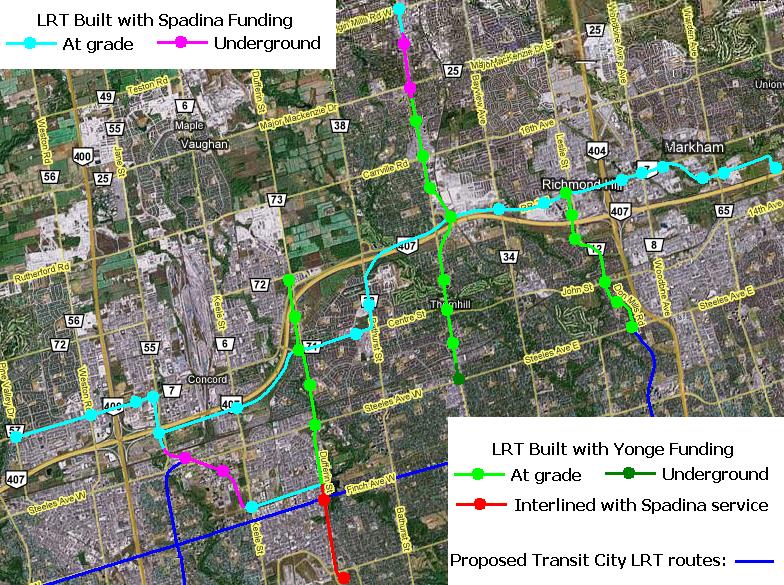Rapid Transit Options in York Region
This is the original page on this subject originally created in 2008 when the small possibility of changing the plans for the Spadina subway extension existed...
This page will look into comparing LRT and Subway rapid transit options for York Region, with focus on the proposed Spadina and Yonge Subway extensions. To get an understanding of what the terms LRT and Subway mean (along with BRT, Commuter Rail, and DMU), take a look at this page. Commuter rail and DMU have their places, and GO Transit provides three corridors of service in York Region. In considering rapid transit expansion, the other three are the viable options available.
This page will look at the various alternative options to the Yonge and Spadina Subway extensions that are possible with the same capital cost or less. This should be obvious, but these are not official plans, just ideas. To quote transit activist Steve Munro, "the moment someone draws a map, the concrete starts to harden and people treat proposals as done deals", so please keep that in mind!
The plans to move VIVA to phase 2, that would provide a true BRT implementation, should move ahead as soon as possible across parts of the VIVA system that are not yet ready for greater capacity. Eventually, these may need to be upgraded to LRT operations, but if a central portion were to be built with LRT today, instead of Subway, future expansion using LRT technology is made simpler. One great benefit of LRT is it is more cost effective for incremental expansion. This not only means extending existing lines or adding new lines, but it also means expanding platform lengths to allow 3-car operation instead of 2-car operation (a 50% increase in capacity for a small capital cost and a negligible increase in operating cost).
However, with money either committed or being offered to extend Subway operations over two specific corridors, it is important to consider LRT. Will LRT provide for the commuting needs into the foreseeable future? The lower cost of LRT implementation can mean that a greater degree of LRT can be built with the same funding. Alternatively, given current economic conditions, if funding may have to be limited, perhaps we should consider LRT as a way to provide the currently needed capacity for a lower cost that is also a cost effective way to expand for future needs.
For the same cost as subway construction, LRT can provide the level needed to a greater number of riders and potential riders. This greater penetration of a rail-based rapid transit implementation at this time would also result in a savings in both funds and inconvenience of constructing BRT lanes at this time over these areas.
Given that in addition to subway construction, some portions of the VIVA network will be moving towards Phase 2, with dedicated bus lanes, it would be a better use of funding to use an LRT approach in place of both of these projects, as this will not cost any more than the subway construction alone.
The Yonge Street corridor north of Highway 7, definitely to Major Mackenzie Drive and possibly to Elgin Mills Road, and at least 5 km each way at Yonge along Highway 7 are corridors that can be identified as areas that will need to move to Phase 3 at some point in the future. LRT technology could provide more than ample capacity for the foreseeable future.
Before we go into the specifics of comparing the cost of LRT versus Subway for both the Spadina Extension to Vaughan and a Yonge extension to Highway 7, take a look at what typical costs of construction of these two modes actually are on this page. In summary, these are typical costs (not including vehicles):

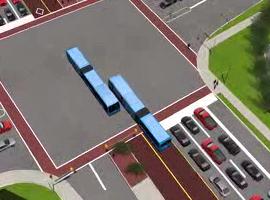
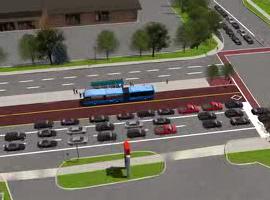
- Subway underground: $200-250 million per kilometre
- Subway at grade: $150-200 million per kilometre
Despite that range, the Spadina extension is expected to cost $2.5 billion for a total of 8.6 kilometres. That is a whopping $291 million per kilometre. Separating the extension north and , the southern portion comes in at $242 million per kilometre, while the portion from Steeles to the Vaughan Corporate Centre (mostly above ground, though some will be 407) comes in at $416.6 million per kilometre!
The Yonge extension as proposed is expected to cost another $2.4 billion for a total of just over 6 kilometres. It should be noted that only about $1 billion of that is for the extension north of Steeles, as this site will propose building the extension to Steeles and will look at what that $1 billion can do if used for LRT construction. At the same time, it is extremely important to also realize that there are conditions on building the extension to Highway 7 to ensure that the line can handle the added passenger load properly and safely. These include expanded fleet capacity under full Automatic Train Control (ATC), additional 50-foot trailer coach to new train sets, major reconstruction of the Bloor-Yonge station, and possible yard access via Sheppard Avenue West. All of this could cost nearly ANOTHER $2.5 billion dollars to the cost of this extension, though this added cost will not be officially attributed to this extension. To be fair, some of these additional costs will exist regardless of the extension, so it would be more accurate to say this would add another $1.9 billion. This means that the extension to Highway 7 will cost about $4.3 billion dollars, though the public will be told it will only cost $2.4 billion!
Typical LRT costs are as follows (including vehicles):
- LRT underground: $130-160 million per kilometre
- LRT at grade: $30-50 million per kilometre
For an understanding on the capacities available with LRT and Subway, take a look on this page.
Why not expand Subway?
Would you pay for something and use half its potential?
Subway expansion is very costly, so it is imperative that the expense be justified. Is the capacity that a full Subway necessary now? In the future? Ever? If not, then perhaps some trains will turn back at Finch or perhaps Steeles. That means that some people destined for stops north may have to get off a train and wait for the next one to complete their trip. Will it ever be necessary, or even possible to run every train all the way to Highway 7.
To understand the reason why, one must consider just how frequently a train can be run. There is a good explanation of this on Steve Munro's website at this location and at this location. A signaling system will be installed on the Yonge line to replace what is currently there and this new system will allow a shorter headway compared to the current 150 second headway (2 minutes, 30 seconds). A 90-second headway has been suggested, but a headway as short as 110 seconds is more realistic. This will increase the capacity of the line by about 20%. This is part of the conditions needed for the extension on Yonge to Highway 7.
The problem is that even with the new signaling system, it is physically impossible to reduce the headway below 120 seconds at terminals. Realistically, the practical lower limit is more like 140 seconds as this leaves a small amount of headroom to compensate for variations from operator's reaction time to passengers attempting to squeeze into doors at the very last moment. There are two ways to get around this: a loop terminal or multiple turn-back pocket tracks.
Loop Terminal
The first is to not have a stub-end terminal where trains arrive, operator changes ends, and leaves in the opposite direction. Instead, a turning loop is used. A train arrives and unloads passenger on one track, then leaves empty to enter a loop. The empty train traverses the loop and returns to the loading platform. This changes the terminal operation to be the same as any other station on the line. An alternative would be to have the terminal station on the loop itself, with one stop opening doors on one side for unloading followed by opening doors on the other side for loading. This alternative, however, restricts the ability to extend the line without major reconstruction of the terminal station. The major problem with a loop is that it can be very large, depending on how fast one plans to operate trains over the loop.
According to specifications for the Spadina Extension, the desired minimum radius is 750 metres, but the absolute minimum radius is 300 metres. A train without passengers could take a sharper turn at a higher speed, but if carrying passengers, it would be rather discomforting if the curve were entered at a higher speed.
Plans for a Yonge extension do not call for a loop, so the cost of the loop is not part of its expected costs. To get an idea of the space required for a loop with a 500 metre radius, click on the image to the right.
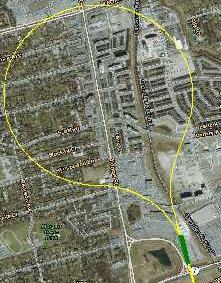
How large is a 500 metre radius loop?
With a terminal station under the current Richmond Hill Centre VIVA station, this gives a rough idea.
Multiple Turn-back Pocket Tracks
A more cost-effective solution is to turn trains back using a centre "pocket" track beyond the terminal station. A train arrives and unloads passenger on one track, then leaves empty to enter a the pocket track beyond the station. The empty train to the loading platform. Scheduled short-turn trains at St. Clair West currently use this procedure. This procedure is only slightly quicker than using a near-side cross-over as is currently done at Finch and Downsview, so a 120-second minimum turn-around time is more likely possible. However, if two pocket tracks were installed, one after the other, the throughput of the terminal is increased.
It is even more cost-effective to use this not by building two pocket tracks at a single location, but by making use of existing pocket tracks at other locations. This is the purpose of the short-turn trains at St. Clair West. By separating half the trains needing to be turned back from the terminal, and having them turn back at another station, it is possible to have a tighter headway as far as the short-turn location. For example, north of Finch station, there is a centre pocket track. A train turning back at Finch can offload its passengers and proceed north into the pocket track. As every other train continues beyond Finch, their headway is one train every 220 seconds. The train turning back at Finch can proceed south into the station after a train coming from further north has departed, and it may depart southbound 110 seconds later.
This operation will be initially used on the Spadina extension, as described by the TTC itself in this document under the heading Steeles West Station. The document states that the Steeles West Station complex will some service "will be used to short turn subway service until full service is necessary to the Vaughan Corporate Centre." Based on ridership projections for many years, this means never. The rush-hour turn-back trains at St. Clair West will be moved to Glencairn, so not all trains will go north of there. It is likely that only half of the rush hour trains that reach Steeles West will go all the way to Vaughan. Imagine traveling home and having to get off at Glencairn to wait for the next train, then have to get off at Steeles West to wait for another train to get all the way to Vaughan.
In the plans for the Yonge North extension (see this report [13.2 MB] and this presentation [5.1 MB]), it is expected that initially this operation will only be needed during morning rush hours in order to provide southbound trains that are empty from Finch. Though the plans call for afternoon rush hour trains to all terminate at Richmond Hill Centre, don't be surprised if this changes and some trains will eventually be short-turned at Finch.
With apologies to Joni Mitchell, extending Subway lines mean build mega-parking lots at suburban stations. The plans for both the Spadina and the Yonge subway extensions do not have parking space at every station. For these extensions, only the following parking spaces will be provided:
- possible spaces at Steeles West station (Spadina extension)
- 600 spaces at 407/Transitway station (Spadina extension)
- 2000 spaces at Langstaff/Longbridge station (Yonge extension)
There are two main sources of growth in transit usage: converting automobile commuters, and capturing new residents before they become automobile commuters. The latter group is relatively easier to capture - all you need is fast, frequent, and reliable transit in service before they move in. It is the current automobile commuters that are difficult to capture.
Some will be naturally captured by a rapid alternative, but think about how they will get to a station. A small number will be within walking distance. A few more will be willing to take a short bus ride to the station if it is convenient. Most, however, will drive their cars to the station. The catchment area of one Subway line is quite large, so the percentage of people close enough to walk or take a short feeder bus ride is small.
Don't believe this? Look at GO Train lines. Some people can walk to the station. Some will take a YRT GO Shuttle bus for only 50 cents each way. Notice how far from the GO station the shuttle runs? Most travel within a 3 km distance from the station. Compare this with the catchment area. The Unionville station on the Stouffville line is near Kennedy Road and Highway 7, while the Langstaff station on the Richmond Hill Line is east of Yonge at Highway 7. That is nearly 10 km, so a commuter up to 5 km away from either station is part of its catchment area. It is a safe bet that this commuter is not taking YRT routes (note the plural!) to the GO station. The same will happen with both Yonge and Spadina Subway extensions.
Surface LRT construction, at its high end, costs a quarter the price of underground Subway (or the overpriced surface extension from Steeles to Vaughan on the Spadina line). Given that, it is safe to say that one could build three LRT lines for the price of one Subway line. Imagine building three parallel lines that are 4 km apart - so many more people will be within walking distance or within a short bus ride that is under 2 km!
Build a line on Dufferin (which could connect with the Spadina Subway at Downsview), a line on Yonge (connecting with the Yonge Subway line) and a third line on Leslie that could not only connect, but interline with the Transit City Don Mills LRT line! Stations would not have to have mega-parking lots since all the commuters that these will carry will not have to be funneled to a single line on Yonge. As a bonus, when (not if, but when) a line has an emergency shutdown, easy to get to alternatives exist.
Some might be quick to argue that the same parking is needed, just spread out. Simple logic would say that three lines would have one-third the number of parking spaces. However, by having more stations spread over a wider area where each has a smaller catchment area, the total parking requirements are reduced. This is because the percentage of people who can either walk or will be willing to take a short bus ride to the station will increase because of the greater number of stations closer to potential commuters.
LRT Possibilities Around Yonge Street
There is a place for Subway expansion, but only where absolutely needed. It is far too expensive technology to use simply because it would be a nice convenience. Proponents of extending Subway lines will cite the inconvenience of transferring. If we were build an LRT line from the terminal of an existing Subway line, instead of extending the line itself, people will have to transfer from one vehicle to another: "I want a one-seat commute!"
The problem with this argument is that existing users already transfer from a bus. The argument is invalid for new users, since most every new user will need to transfer somewhere in their commute as very few people are served by a single route between their source and destination.
The transfer issue can be a valid argument for some existing users who take a bus and transfer to the Subway, but now they will take a shorter bus ride to the LRT station, transfer to the LRT, take it to the Subway, and transfer again. It is likely that the time required for the new transfer between LRT and Subway will be much less than the time saved by the shorter bus ride. If an across-the-platform design is used, this transfer would be very quick compared to a bus-to-subway transfer that involves changing levels. Furthermore, as LRT offers the most economic solution for future incremental expansion, there exists a greater possibility for more people to see the elimination of the bus/LRT transfer when the LRT network is expanded.
For instance, traveling from the area of Woodbine and Highway 7 to downtown currently requires taking one or two VIVA buses to get to Finch Station. Assuming the user catches a VIVA Pink bus, that will take them to Finch Station transfer free. They transfer to the Subway and travel downtown. If the Subway were extended to Yonge and Highway 7, they still must take a bus to get there. All they have done is move the transfer point. A LRT implementation up Yonge has the advantage that due to its lower cost, it does not have to end at Highway 7 and Yonge. A Highway 7 LRT route could be built that would allow this same user to travel all the way to the Subway by LRT without any other transfers.
Extend Yonge Line to Steeles
While this site primarily promotes LRT, the stretch of Yonge Street from Finch to Steeles is a prime candidate for a Subway extension for a number of reasons:
future Subway capacity increase by decreasing the headway on the Yonge line south of Finch by having only half the trains go to Steeles (it is far more efficient to use a 2 km extension for half the rush-hour service, compared to using a 6 km extension this way)
Yonge street from Finch to Steeles is too crowded for surface transit options (including LRT and the proposed busway)
the TTC's Steeles East and Steeles West routes have to do the 2 km jog down to Finch
a new Subway terminal at Steeles can be designed and constructed with underground LRT transfer capabilities, making easier transfers for passengers (see diagram at right)

One possible design for a Steeles station that provides an easy connection between Subway and LRT. Keep in mind that one benefit of LRT is that tracks may be crossed, so this does not divide the platform in the same way that an additional subway track would, requiring stairs to be taken to get to the other side.
This two kilometre extension of the Yonge Subway is planned to cost approximately $1.5 billion. The current plans include the cost of 25-26 underground bus bays at Steeles and a station at Cummer/Drewry.
A further four kilometre extension to Highway 7 would cost approximately $1 billion. This extension has four stations planned, though one may not be built.
If using an LRT option, what could that $1 billion build instead? Let us look at some possibilities...
Yonge Option 1: Underground LRT to Highway 7 - with East-West Priority
The Subwaynow group has convinced many businesses in Thornhill along Yonge Street that reserved lanes for VIVA Phase 2 would be too disruptive. They attempted to paint a picture of no disruption using tunneling methods, but failed to note that cut-and-cover construction is needed where stations are placed.
From a business point of view, an underground option steals away potential business as commuters pass through the area without being able to see what is there. That said, let us keep the need for an underground solution in the area for the moment and look at what could be done with LRT technology placed underground between Steeles and Highway 7.
This line could come to the surface just north of Highway 7 for an at-grade station where the Richmond Hill Centre VIVA station currently is located.
Constructing an LRT line underground can cost between $130 million and $160 million per kilometre. Given that tunneling would not be the most complicated in this location (clay soil conditions, plenty of space without a large amount of underground services to be relocated), we will use $150 million per kilometre. Therefore four kilometres would cost $600 million. That leaves $400 million.
LRT on the surface can cost between $30 million and $50 million per kilometre. Assuming that the ROW will have a concrete base, the upper end will be used. That means there is enough funding remaining for 8 kilometres of surface line. Building the Yonge line all the way to Major MacKenzie (an additional 4 km) would cost $200 million, and another a 4 km line could be built along Highway 7 to the Leslie/404 area.
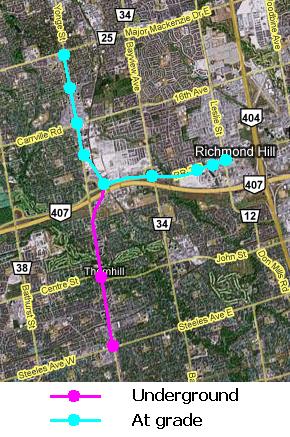
As the ROW between Steeles and Richmond Hill Centre will be underground, it would likely only have a single stop at Centre Street. Current VIVA stations at Clark and Royal Orchard would be eliminated.
Though a little more costly, it may be a good idea to have the Major MacKenzie station underground. Due to tight space from Major MacKenzie to Crosby Avenue (approximately 1 km), a future extension would be easiest if this stretch were tunneled. This possibility will be looked at later.

A possible future site on Yonge Street just south of Major MacKenzie Drive
Yonge Option 2: At Grade Just North of Steeles - with East-West Priority
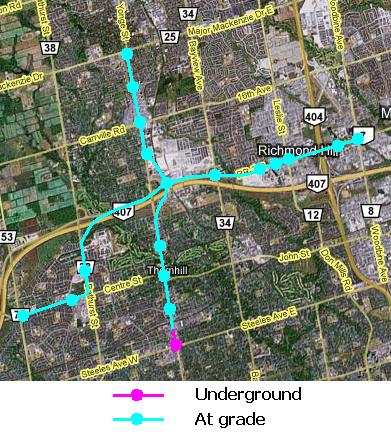
A faster, and more convenient transfer can be made with the Yonge Subway with an underground LRT terminal at Steeles. That idea is continued here, but the line returns to the surface and runs in a median to Yonge and Langstaff. At that point, the line can move off of Yonge Street to pass under the 407 and Highway 7. The cost of these underpasses pushes up the cost of the line, but the ROW east of Yonge Street would be lower cost as it would be tie-on-ballast construction, so the same per kilometre cost will be used.
With the first half kilometre underground from Steeles, that would cost $75 million. 7.5 kilometres to Major Mackenzie would cost another $375 million, for a total of $450 million. Being on the surface, current VIVA stations at Clark and Royal Orchard would be maintained.
The remaining $550 million will build 11 km of surface LRT. That distance is roughly the same as the VIVA purple route from Dufferin and Centre Streets to Highway 7 and Woodbine Avenue.
This east-west priority is nice, but let's leave it and explore another possibility. We will come back and look at an east-west LRT line when we look at what could be done with the funding for the Spadina extension.
Yonge Option 3: At Grade Just North of Steeles - Parallel Route Priority
An alternative to an east-west priority would be to provide parallel line operation. This has the effect of spreading the width of the catchment area with the added benefit of providing alternative north-south capabilities for emergency situations that may block a corridor.
Like in Yonge Option 2, the LRT on Yonge Street is the same, costing $450 million.
West of Yonge Street, a second line could be built on Dufferin Street from the Downsview Subway station all the way up to Langstaff. The southern-most 2-2.5 km of this line could be shared with the Busway to York University. This could reduce total cost of the line if constructed at the same time, but for purposes here, it is assumed that it is separate.
The first six kilometres, to just south of Centre Street, would have to be built in a median for about $50 million per kilometre, for a cost of $300 million. Just south of Centre Street, the line can shift to the west side of Dufferin and run on a parallel ROW up to Langstaff. There are a limited number of roads and driveways along here, however the line would be best located on the west side of these properties, so no railway crossing type protection would be required. This alignment would reduce the cost of the line here to the lower end at about $30 million per kilometre for this 2 km stetch. The total cost for the Dufferin line would be $360 million.
East of Yonge Street, a third line could be built on Don Mills/Leslie from Steeles up to Highway 7. At Steeles, the line would meet the Transit City Don Mills line. A great benefit with this is that interlining operation would permit runs further south to either the Don Mills Subway station or possibly further south. The first 3 km of this line from Steeles to just south of the 407 would be in a median, costing about $50 million per kilometre, or $150 million in total. From this point, the line could swing to the west side of Leslie Street due to the limited number of roads and driveways for the 1.5 km to Highway 7. This makes the total cost of this line $195 million.
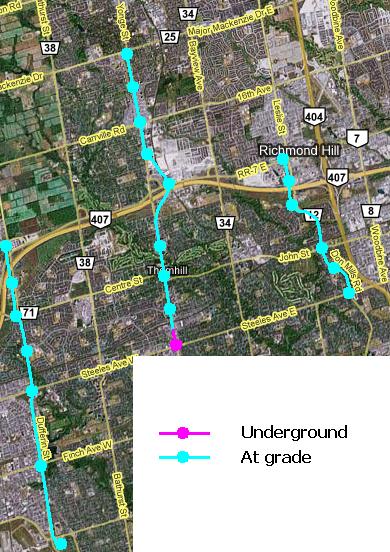
While the total for these three lines is $1.005 billion, some costs could be saved by limiting the underground portion on Yonge Street north of Steeles to only 200 or 300 metres (500 metres was used for the calculation).
LRT Possibilities For Spadina Extension
When one takes a close look at current and projected rider numbers for the Spadina Extension corridor, this really does not warrant an extension of the Subway line (current northbound morning travel to York U is about 5500 spread over two hours - 3000 riders per hour is only one-tenth of the capacity of our current Subway operations). We will first look at what could be done if the subway were to be extended to Steeles West and the reamaining funding ($1 billion) were used for LRT construction, then we will look at what can be done if the entire $2.5 billion expected cost were to be shifted to LRT.
Alternatively, we will look at extending Subway service only to Steeles West (between Keele and Jane). This would free up the $1 billion allocated for the 2.4 km extension from Steeles West to the Vaughan Corporate Centre (VCC) at Highway 7. It has been suggested that a more useful Subway extension to Steeles West would be to extend the Sheppard line west from Yonge to Downsview, then follow the route to Steeles West (see here for an example). This extension would involve close to 4 km of additional Subway and that would use up the $1 billion, leaving nothing for any LRT expansion. If the entire $2.5 billion absolutely had to be spent on Subway expansion, then this would be a better way to spend the money as it would provide a useful northern connection between the Yonge and Spadina Subway corridors plus a useful cross town connection to and from destinations such as York University and the east end. Interestingly, one of the proposals that has come forward with the Yonge extension is the need for this subway connection on Sheppard West to provide better access to storage facilities at the Wilson Yard. In the end, we may have this added cost on top of the Yonge and Spadina extensions!
Spadina Option 1: Subway Extension to Steeles West
In this option the Spadina line is extended, but only as far as the proposed Steeles West station on the north side of Steeles Avenue between Keele and Jane. Service to the Vaughan Corporate Centre would be provided by LRT, but due to LRT's lower cost service can go beyond the intersection of Jane and Highway 7.
This portion of the Subway extension is expected to cost $1 billion, which will be used for our LRT budget.
With the Spadina subway ending at Steeles West station, a street-level LRT platform would be available in the terminal to provide connections with both the Transit City Jane line and the LRT line to Vaughan.
Both LRT routes would interline along Steeles to Jane Street, where the Transit City line would turn south and the York Region line would turn north. Shortly north of the intersection, this line could move to a ROW on the west side of the road and from here to VCC, the LRT would roughly follow the alignment of the proposed Subway extension. A new underpass is needed where it crosses under the CNR line, then the ROW would have to be elevated to cross over the 407 before returning to grade level. This part of the line would cost about $125 million to build.
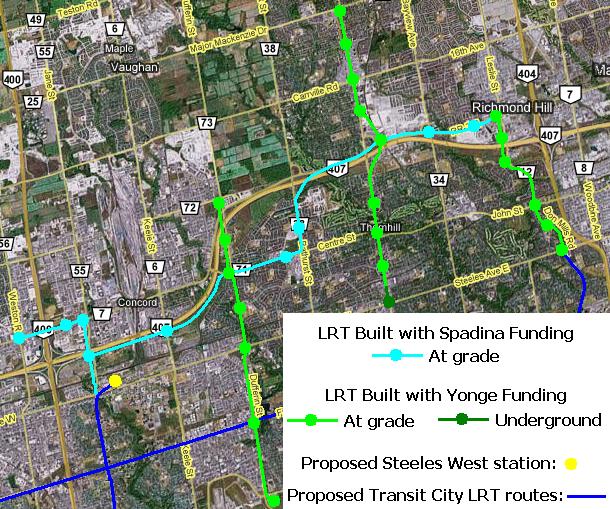
This line would continue west in a median on Highway 7 from Jane as far west as Weston Road for a cost of $100 million. An eastern line starting at Jane and the 407 could also be built as far east as Leslie Street for $775 million ($450 million to Bathurst and 407, $175 million from there to Richmond Hill Centre, and $150 million from there to Leslie). A breakdown of these costs will be shown in the next option.
This option works with Yonge Option 3 by providing an east-west connection between the lines. A great benefit to this type of connection is that it provides an easy way for people to get to another north-south line should a problem arise on a line that prevents normal operation of a line.
Spadina Option 2: No Subway Beyond Downsview
There are a number of options available when $2.5 billion is available for LRT operations. With no Subway extension beyond Downsview, rapid transit service to York University's campus will only involve LRT. For many years, York U has had a strong voice lobbying the TTC and the City for a Subway extension. It almost seemed like a child's rant because their siblings (U of T and Ryerson) had something (front-door Subway stops) that they didn't. It also seems illogical that an institution that are likely lobbying the provincial and federal governments for increased funding for education would want to put so much effort into having those levels of government divert funding into an overkill rapid transit plan.
While it is important that an efficient, rapid way of moving staff and students into and out of a university campus, there simply is not the demand to warrant the cost of Subway expansion. There is an advantage to a subterranean transit solution, but rather than take that point and conclude that an HRT subway is necessary, let us look at placing an LRT in a tunneled section through the campus of York University.
This example will assume that Yonge Option 3 is selected. This has a Dufferin LRT line from Downsview station north to Langstaff Road. This LRT operation will interline with the Dufferin route from Downsview station to the hydro corridor just north of Finch. New construction begins here where this line follows the corridor currently being developed for BRT operation. Costs could be lowered by building this ROW with ballasted tie tracks, but we will assume it will be concrete to allow bus operation. This line would run 2 km west to just past Keele Street where it would then go underground. The York University and Steeles West stations would both be underground on a section of the line approximately 2.5 km long.
Reaching Steeles West, the cost of this option is about $475 million. Note that this line will have a connection with the Finch West LRT line at Dufferin and Finch, and with the Jane LRT line at Steeles West. If we reserve $125 million to connect the Jane line underground between the Steeles West station and the intersection of Steeles and Jane, we can benefit from interlining capabilities. This can allow riders heading up Jane for York U to travel without having to transfer at Steeles West. The total cost is now $600 million.
From here to VCC, the LRT would roughly follow the alignment of the proposed Subway extension. Staying underground for about a half kilometre until it was on the west side of Jane Street, the line would come to grade level and continue on a ROW to the west of the street.
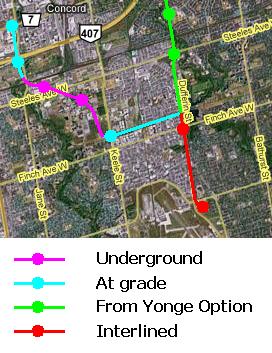
A new underpass is needed where it crosses under the CNR line, then the ROW would have to be elevated to cross over the 407 before returning to grade level. The route on the west side of Jane Street could be built for lower costs with ballasted tie construction, but the railway underpass and the 407 overpass would add to costs, so the upper figure of $50 million per kilometre is more in line with the overall cost. With about a half kilometre of underground construction and nearly 2 kilometres of at-grade construction, this section will cost about $175 million.
This provides an LRT option from Downsview to VCC for only $775 million. With the remaining funding, it is possible to build an east-west LRT line along Highway 7 and/or the 407 such as in Yonge Option 2 above - only instead of Dufferin to Woodbine, from Pine Valley Road to the Unionville GO station!
Since this LRT line is essentially the east end of the VIVA Orange route, let us extend it west in a median on Highway 7 from Jane to Pine Valley Road, about 4 km, for a cost of $200 million.
From the 407 Transitway stop just south of Highway 7, a new line could replace the VIVA purple route as far east as the Unionville GO station. The only portion of this line that would be different from the current VIVA purple route is that it would follow the south side of the 407 from Keele Street to Centre Street. This would share the proposed ROW of the 407 Transitway BRT route from Keele to the CNR Newmarket subdivision. (You can look at details of the 407 Transitway in this document, but beware: it is over 20 MB in size!)
The line would be at grade with Centre Street as it crossed its eastbound lanes into a median. From here it would follow the current VIVA purple route along Centre and north on Bathurst to just south of the 407. This section from Jane and the 407 to Bathurst and the 407 would cost approximately $450 million.
A bridge would take the line over the 407 and curve to the east to a ROW between the 407 and Highway 7. The line would have to pass under Highway 7 to reach Richmond Hill Centre. The bridge at Bathurst and the underpass at Yonge could easily cost $100 million, but the 2 km of ROW would be tie on ballast construction, for a total cost of about $175 million.
East of Richmond Hill Centre, the line would return to a median on Highway 7 for the 6.9 km distance to just east of Woodbine Avenue for a cost of approximately $345 million.
About 400 metres east of where the current Montgomery VIVA station, the line would leave the median of Highway 7 and curve to the southeast. Here the ROW would follow the north side of a ravine to get to just north of the intersection of Warden and Enterprise Drive, crossing roads as railway level crossings and continuing north of Enterprise Drive (following the proposed busway ROW for VIVA Phase 2) until passing over the railway line and curving to the south to pass over Enterprise Drive. The ravine section and the stretch to the railway overpass, with ballasted tie construction, would cost about $100 million, and the final bridge structure over the railway and the stretch to the GO station another $50 million.
The total for this so far comes to $2.095 billion. That still leaves us with $405 million.
Part of this remainder can be used to extend the Yonge LRT line all the way to Elgin Mills Road. This is only a 2 km extension beyond Major MacKenzie Drive where the line would end under the proposal for Yonge Option 3. However, the 1 km stretch of Yonge Street from Major MacKenzie Drive to Crosby does not have room for a ROW, so tunneling is more appropriate here. Given that the tunnel would have to start just south of Major Mac and extend to just north of Crosby, a length of 1.5 km is used to determine the cost. This would make the tunnel about $240 million and an additional kilometre of median ROW for another $50 million. The remaining $115 million should be reserved for the cost of a carhouse/maintenance facility.
LRT Possibilities For Spadina Extension
An important point to keep in mind, is that unlike Subway, LRT offers a very cost effective way of incremental expansion once the initial line is built. Extending a line a few kilometres, or building a branch off a line, is very cost effective. Also, if at-grade platforms are initially built for 2-car trains, it is relatively easy and cost effective to extend these for 3-car trains if needed, especially in York Region where space makes a 3-car train more practical that within Toronto.
Another advantage in York Region is that extensions into developing areas can take advantage of ROWs other than a roadway median. Building a line parallel to a main street often has costs at the lower end of the scale as ballasted tie construction may be used. Such construction is not practical if there are many intersections with side streets and driveways, but this can be controlled in a developing area.


In Minneapolis, traffic on Hiawatha Avenue is warned of an approaching LRT on the parallel ROW with a flashing sign (left photo) when arriving at an intersection. At the intersection, a lighted No Right Turn sign and crossing gates prevent traffic from passing until the LRT passes.
